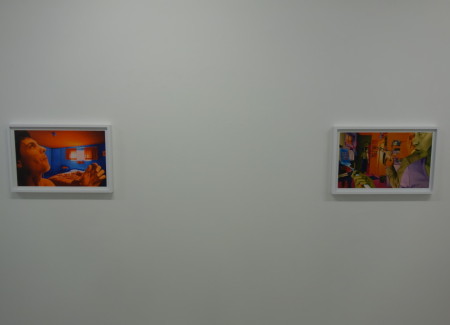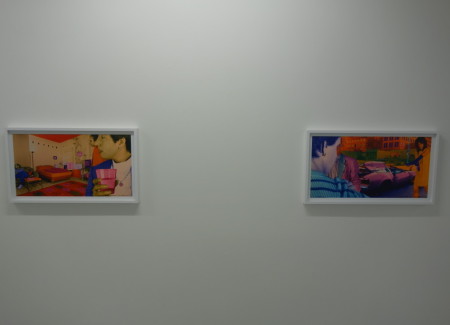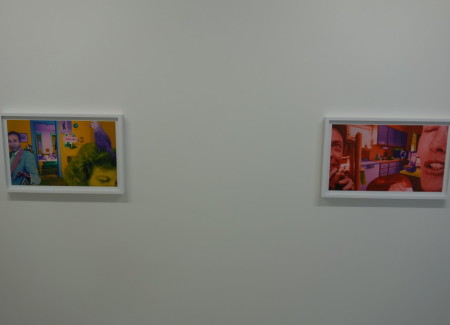JTF (just the facts): A total of 10 color photographs, framed in white and unmatted, and hung against white walls in the main gallery space. All of the works are archival pigmented inkjet prints, made in 2005. The prints are sized between roughly 16×25 and 16×29, and each image is available in an edition of 10. All of the images come from the series True Fiction Two. (Installation shots below.)
Comments/Context: Like the gradual transition from black and white to color, the changeover from analog to digital has disrupted the careers of many established photographers. The artists “born” after the switch have had a comparatively easier task – they’ve only had to discover and master the new technology, not consciously unlearn all their old (and often highly successful) habits. Many of the careful optimizations built up over decades, both aesthetic and technical, have suddenly been called into question, with new approaches and methods opening doors that were previously thought to be stubbornly locked. The brash, unsettling question is how the mid- or late-career artist will respond to this change in circumstances. The history of photography offers a wide spectrum of answers, from hardcore holdouts and timid testers who never really commit to the new technology, to curious explorers and full-fledged converts.
Sandy Skoglund’s 2005 series True Fiction Two offers a fascinating case study in this kind of technical transition. Skoglund is of course best known for her elaborately constructed pre-Photoshop installations, where seemingly every inch has been filled with hand crafted sculptural goldfish, or squirrels, or foxes in eye popping colors and inexplicable positions. Her playfully surreal interior tableaux have a signature look and feel, her staging honed to her own brand of visual perfection. But these now familiar installations aren’t even close to her only body of work, and back in the mid 1980s, Skoglund made a photocollage series (True Fiction One), mixing black and white images of friends, family, and familiar locations with bold darkroom tinting, rephotography, and dye transfer printing. The project was originally exhibited in 1986, but ultimately cut short (and shelved) in 1989 with the demise of the discontinued dye-transfer materials. As we jump ahead a couple of decades, the newfound tools of the digital revolution have made it possible for Skoglund to remake those old photocollages more as she first intended. So the 2005 project on view here is a modern reworking of those 1980s scenes, an opportunity to realize her original vision, leveraging more powerful techniques that weren’t available the first time through.
Skoglund’s compositions upend our usual assumptions about scale, with large foreground faces matched with domestic interiors and parked cars in the back. These cropped faces and bodies push out into our space, a held spatula or toothbrush looming extra large, a flipped Rolodex, cat kibble, or a drinking glass interrupting our view, the various men and women seen slightly too up close, like a jostling overcrowded cocktail party. Her combinations of gestures and facial expressions feel wilfully disjointed, with stares and glances swinging across the frame and away from some notion of front and center. Apartment-sized kitchens, living rooms, and bedrooms generally provide a wider domestic setting for these inserted and mismatched actors, except when the action appears to move outside to streets filled with dead and crumpled cars. These urban scenes are even more off-kilter, as the people seem to have been dropped down with purposeful disregard of relative sizing.
But it wouldn’t be a Sandy Skoglund picture without some supersaturated Willy Wonka-style coloring, and the new digital color tinting tools have allowed her to turn up the chaotic volume even further on these compositions. Some of the works are tinted in just two colors (blue/orange or pink/green, opposites on the color wheel, for maximum pep), but the tinting is meticulously selective, with small light fixtures, curtains, tile patterns, and wall colors forced to alternate in a dance of matching contrasts. Other compositions go further, to three and four color combinations, with key items seeming to stand out – a kitchen blender, some long gloves, and a parakeet (all in purple, but in different images), a crashed car and a throw pillow (in pink), and a toothpaste tube, a dinner jacket, and a baseball hat (in blue). It’s as if we’ve dropped into candy-colored parallel world, where the familiar has become brightly enhanced and quietly (and a bit invasively) mis-sized.
What’s fascinating about these images is that they don’t look like the photographs being made by emerging digital natives – Skoglund has brought her own refined aesthetic to these decisions. The pictures feel like Skoglund, but with additional freedoms, not “new and improved” in a unidirectional sense, but more like a swirling evolutionary process, where older ideas are being reconsidered and reincorporated in the context of new possibilities. The digital realm is one that should be well matched to the wild imaginings of Skogund’s art making. As seen in the works in this show, it’s intriguing to watch her incrementally cross over, fitting her ideas into an expanded artistic playground.
Collector’s POV: The prints in this show are priced at $8500 each. Skoglund’s prints have been consistently available in the secondary markets over the past decade, with prices ranging from roughly $2000 to $48000.









